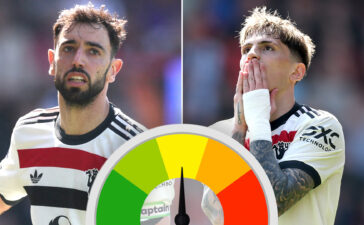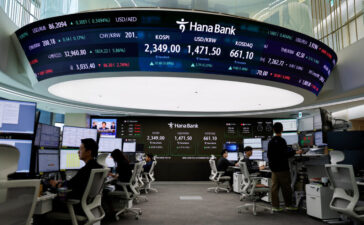- The Indian Rupee attracts some sellers in Wednesday’s early Asian session.
- The weakening in Asian peers and month-end USD demand weigh on the INR.
- Investors await the Fed’s Waller and Bostic speeches on Wednesday for fresh impetus.
The Indian Rupee (INR) extends its losses on Wednesday, pressured by the weakness in Asian peers and US Dollar (USD) demand from importers. Nonetheless, positive domestic markets and Federal Reserve (Fed) Chair Jerome Powell’s dovish comments at the Jackson Hole meeting last week might cushion the local currency’s downside.
Later on Wednesday, the Fed’s Christopher Waller and Raphael Bostic are scheduled to speak. The advanced US Gross Domestic Product (GDP) Annualized for the second quarter (Q2) will be published on Thursday, which is projected to grow 2.8%. On Friday, the US Personal Consumption Expenditures (PCE) Price Index and Indian GDP Quarterly for the first quarter (Q1) of fiscal 2024-25 (FY25) will be in the spotlight.
Daily Digest Market Movers: Indian Rupee looks fragile despite dovish Fed
- The International Monetary Fund (IMF) projected that India’s real GDP growth will touch 7% in 2024 to remain the fastest-growing major economy in the world.
- According to a Reuters poll, India’s economic growth in the April-June quarter was anticipated to expand at its slowest pace in a year owing to lower government spending.
- The Conference Board’s US Consumer Confidence Index rose to 103.3 in August from an upwardly revised 101.9 in July, marking a six-month high.
- The US House Price Index dropped by 0.1% MoM in June, better than the estimation of a 0.2% increase, the Federal Housing Finance Agency showed onTuesday.
- Futures are currently pricing in a near 34.5% chance of a half-percentage point cut in interest rates, according to the CME FedWatch Tool.
Technical Analysis: USD/INR’s positive outlook remains in play
The Indian Rupee weakens on the day. Technically, the constructive picture of the pair remains intact as the price is above the key 100-day Exponential Moving Average (EMA) on the daily timeframe. The 14-day Relative Strength Index (RSI) remains above the midline near 58.00, suggesting that the support level is likely to hold rather than break.
The first upside barrier to watch for USD/INR is the support-turned-resistance level at the 84.00 psychological level. Any follow-through buying above this level could pave the way to the next hurdle near the record high of 84.24 en route to 84.50.
In the bearish event, the low of August 20 at 83.77 acts as an initial support level for the pair. Extended losses could expose the 100-day EMA at 83.60.
US Dollar price today
The table below shows the percentage change of US Dollar (USD) against listed major currencies today. US Dollar was the weakest against the Australian Dollar.
| USD | EUR | GBP | CAD | AUD | JPY | NZD | CHF | |
| USD | 0.08% | 0.07% | 0.01% | -0.15% | 0.32% | 0.03% | 0.18% | |
| EUR | -0.07% | -0.01% | -0.06% | -0.23% | 0.24% | -0.05% | 0.11% | |
| GBP | -0.08% | 0.00% | -0.07% | -0.23% | 0.25% | -0.04% | 0.11% | |
| CAD | -0.01% | 0.07% | 0.06% | -0.17% | 0.30% | 0.02% | 0.16% | |
| AUD | 0.15% | 0.23% | 0.23% | 0.16% | 0.45% | 0.20% | 0.32% | |
| JPY | -0.32% | -0.24% | -0.25% | -0.31% | -0.47% | -0.28% | -9915.37% | |
| NZD | -0.03% | 0.05% | 0.04% | -0.02% | -0.18% | 0.31% | 0.13% | |
| CHF | -0.19% | -0.11% | -0.10% | -0.16% | -0.33% | 0.10% | -0.15% |
The heat map shows percentage changes of major currencies against each other. The base currency is picked from the left column, while the quote currency is picked from the top row. For example, if you pick the Euro from the left column and move along the horizontal line to the Japanese Yen, the percentage change displayed in the box will represent EUR (base)/JPY (quote).
Indian Rupee FAQs
The Indian Rupee (INR) is one of the most sensitive currencies to external factors. The price of Crude Oil (the country is highly dependent on imported Oil), the value of the US Dollar – most trade is conducted in USD – and the level of foreign investment, are all influential. Direct intervention by the Reserve Bank of India (RBI) in FX markets to keep the exchange rate stable, as well as the level of interest rates set by the RBI, are further major influencing factors on the Rupee.
The Reserve Bank of India (RBI) actively intervenes in forex markets to maintain a stable exchange rate, to help facilitate trade. In addition, the RBI tries to maintain the inflation rate at its 4% target by adjusting interest rates. Higher interest rates usually strengthen the Rupee. This is due to the role of the ‘carry trade’ in which investors borrow in countries with lower interest rates so as to place their money in countries’ offering relatively higher interest rates and profit from the difference.
Macroeconomic factors that influence the value of the Rupee include inflation, interest rates, the economic growth rate (GDP), the balance of trade, and inflows from foreign investment. A higher growth rate can lead to more overseas investment, pushing up demand for the Rupee. A less negative balance of trade will eventually lead to a stronger Rupee. Higher interest rates, especially real rates (interest rates less inflation) are also positive for the Rupee. A risk-on environment can lead to greater inflows of Foreign Direct and Indirect Investment (FDI and FII), which also benefit the Rupee.
Higher inflation, particularly, if it is comparatively higher than India’s peers, is generally negative for the currency as it reflects devaluation through oversupply. Inflation also increases the cost of exports, leading to more Rupees being sold to purchase foreign imports, which is Rupee-negative. At the same time, higher inflation usually leads to the Reserve Bank of India (RBI) raising interest rates and this can be positive for the Rupee, due to increased demand from international investors. The opposite effect is true of lower inflation.















